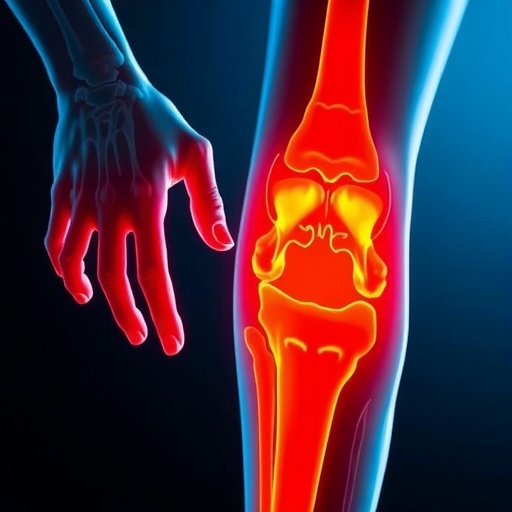
Researchers have recently turned their attention to a significant interplay between sarcopenia and hypercoagulability, particularly in elderly patients suffering from chronic obstructive pulmonary disease (COPD). This burgeoning field of study addresses vital questions about how these two conditions may exacerbate each other and contribute to adverse health outcomes in older adults. While each condition is concerning on its own, their combined effects can lead to heightened morbidity and mortality, making their investigation imperative for improving clinical management strategies.
Sarcopenia, a condition characterized by the progressive loss of muscle mass and strength, is increasingly recognized as a crucial predictor of health decline in the elderly. The condition can result in functional limitations, falls, and a diminished quality of life. In the context of COPD, where the lungs’ ability to exchange gases is severely compromised, the integration of sarcopenia creates a challenging clinical scenario. Understanding the relationship between muscle loss and respiratory conditions is fundamental for developing targeted therapies.
On the other hand, hypercoagulability refers to an enhanced tendency for blood to clot. This condition can lead to venous thromboembolism, stroke, and other severe cardiovascular events. In elderly patients, particularly those with pre-existing respiratory conditions like COPD, the risk becomes even more pronounced. The inflammatory state often seen in chronic diseases can alter hemostatic balance and potentially lead to pronounced coagulation abnormalities.
The researchers, Tian, Cheng, and Qin, embarked on an extensive investigation to elucidate the association between sarcopenia and hypercoagulability in older adults with COPD. Their study design involved a meticulous collection of clinical data and laboratory markers to assess muscle mass, strength, and coagulation parameters. For those intrigued by the nuances of geriatric medicine, the methods deployed in this study underscore the importance of a comprehensive approach to patient care.
By examining various biomarkers related to muscle degradation and coagulation cascade activation, the researchers aimed to uncover whether a direct correlation existed between the severity of sarcopenia and the tendency toward hypercoagulability. Their findings suggest a complex relationship driven by shared pathophysiological mechanisms, including inflammation, oxidative stress, and physical inactivity—all critical factors that can complicate the clinical picture in these patients.
Furthermore, the implications of these findings reach far beyond academic curiosity. By recognizing the interdependence of these two conditions, clinicians may be better equipped to implement preventative strategies and interventions tailored specifically for this vulnerable population. For instance, integrating exercise regimens that target muscle strength could potentially mitigate both sarcopenia and the risk of thrombotic events, thereby improving overall health outcomes.
Moreover, the socioeconomic factors impacting elderly patients should not be overlooked. Many older adults experience barriers to accessing adequate nutrition, physical therapy, and comprehensive healthcare. These factors contribute to a vicious cycle where inadequate intervention leads to worsened health and increased healthcare costs. It is for these reasons that studies like Tian and colleagues’ provide not only scientific insights but also crucial evidence for policy recommendations aimed at improving geriatric care.
Another noteworthy aspect of this study was the incorporation of a biopsychosocial model in understanding health outcomes. The recognition that sarcopenia and hypercoagulability do not exist in isolation, but rather in interplay with psychological and social factors, allows for a holistic approach to treatment. The aging population, with its unique challenges, requires such comprehensive methods to address the multifaceted nature of health decline genuinely.
The researchers constructed their study on the foundation of existing literature, paving the way for further exploration and validation of their findings. Their hypotheses stem from previous studies that hinted at a potential link between muscle health and coagulation. By quantifying these relationships, they aim to inspire future research efforts not only to better understand disease mechanisms but also to eventually shape treatment protocols.
What remains crucial is the call for increased awareness within the medical community regarding the interconnectedness of physical and systemic health. As the aging population continues to grow globally, the prevalence of COPD, sarcopenia, and hypercoagulability will likely rise, necessitating an evolved understanding and treatment paradigm to accommodate these challenges.
Engaging the scientific community with fresh insights from innovative studies can indeed ripple through clinical practice. By advancing our understanding of sarcopenia and hypercoagulability, we can create a future where elderly patients receive tailored interventions that proactively address both conditions. The delicate balance of managing complex health needs in older adults exemplifies the essence of modern geriatric medicine.
Finally, the findings from this study may encourage healthcare professionals to reevaluate existing treatment methodologies. Collaborations across disciplines—spanning respiratory therapy, physical rehabilitation, and nutritional support—become essential in tackling conditions like COPD and its associated comorbidities. Each discipline brings to the table a unique perspective, ultimately fostering a more coherent care strategy for the elderly.
As this dynamic area of research continues to develop, ongoing investigations into the relationships between sarcopenia and hypercoagulability could illuminate paths toward enhanced clinical guidelines. Clear frameworks for diagnosing and treating these interlinked issues may help transition our collective understanding from merely reactive to more preventive and proactive models of care.
In conclusion, the joint exploration of sarcopenia and hypercoagulability among elderly patients with chronic conditions represents a frontier in medical research. As we refine our grasp of these intricate relationships, we mirror our commitment to enhancing patient care and health outcomes. The pursuit of knowledge in this arena serves both the scientific community and the aging population, steering us toward better health, reduced hospitalizations, and ultimately, a more vibrant life experience for our elders.
Subject of Research:
Relationship between sarcopenia and hypercoagulability in elderly COPD patients.
Article Title:
Association between sarcopenia and hypercoagulability in elderly patients with chronic obstructive pulmonary disease.
Article References:
Tian, H., Cheng, Y., Qin, L. et al. Association between sarcopenia and hypercoagulability in elderly patients with chronic obstructive pulmonary disease.
Eur Geriatr Med (2025). https://doi.org/10.1007/s41999-025-01289-7
Image Credits:
AI Generated
DOI:
https://doi.org/10.1007/s41999-025-01289-7
Keywords:
Sarcopenia, Hypercoagulability, Chronic Obstructive Pulmonary Disease, Elderly Patients, Geriatric Medicine.
Tags: cardiovascular events in COPD patientsChronic obstructive pulmonary disease researchclinical management of sarcopeniahealth decline in older adultshypercoagulability in COPDinterplay between sarcopenia and hypercoagulabilitymorbidity and mortality in elderlymuscle loss and respiratory healthquality of life and muscle strengthsarcopenia in elderly patientstargeted therapies for COPDvenous thromboembolism risk factors




